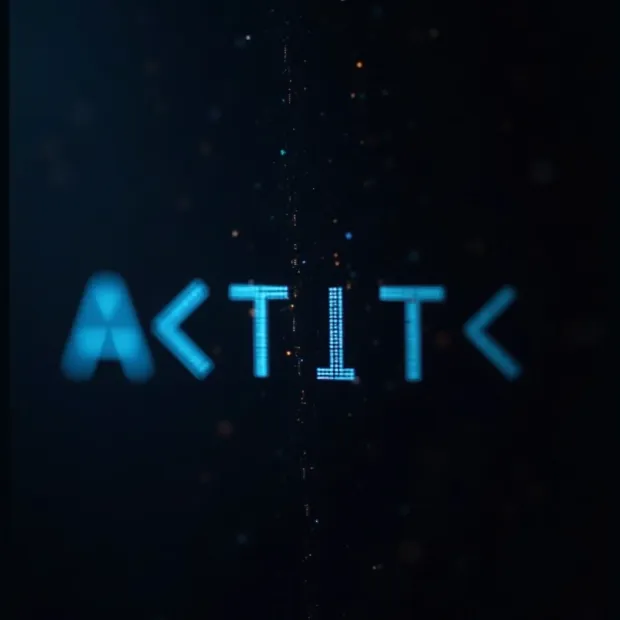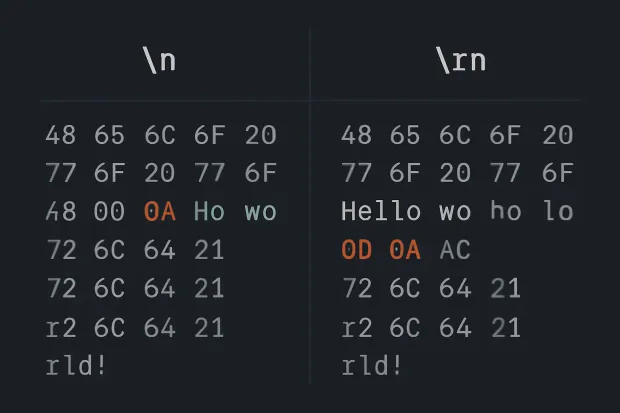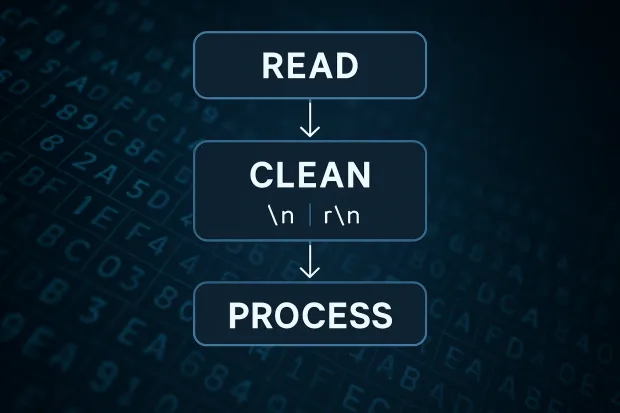Understanding End Of Line: The Power of Newline Characters
End-of-line characters like or may be invisible, but they play an important role in how your code works across platforms. This blog explains EOL characters, their ASCII codes, how Python handles them, and how to avoid common bugs caused by line breaks.


Learn How to Master Digital Trust

The State of Consumer Digital ID 2024

Top CIAM Platform 2024
Introduction
Let’s say you open a .txt file created on Windows, but you’re working on a Mac. Suddenly, your perfectly structured data has strange extra spacing, broken formatting, or worse, lines that don’t even register. What just happened?
Chances are, you’ve run into the mysterious but mighty EOL character, short for End of Line character. It is the unsung hero (or villain) of text formatting, and while it’s invisible on your screen, it makes or breaks how your program processes data.
Whether you’re writing logs, sending API responses, or formatting output in a terminal, these tiny line characters dictate how your text behaves. And yet, they’re often misunderstood.
This blog breaks down everything you need to know from the ASCII new line character to how Python handles EOL characters. We’ll explore the difference between \n, \r\n, and \r, why platforms treat them differently, and how to stop these invisible glitches from sneaking into your code.
You’ll learn: What is the end-of-line character really?, Why do newline characters vary between operating systems?, How does the EOL character in Python behave and finally, what is the ASCII command for a line break, anyway?
So if you've ever wondered about E.O.L. meaning or spent hours debugging line breaks that "shouldn't be there," this blog is for you.

What Is an End of Line (EOL) Character?
Let’s start simple. The EOL character, also known as the newline character, line break character, or end line character, tells your machine: “Hey, we’re done with this line start a new one.”
It’s not something you see. You don’t type it directly (unless you’re working in a hex editor). But the moment you hit the Enter key, your operating system inserts one or more control characters to mark the end of line.
Now, here's where it gets interesting (and slightly messy):
Different systems interpret the "Enter" key differently.
-
Linux/macOS → Inserts \n → That’s ASCII code 10, also called Line Feed (LF).
-
Windows → Inserts \r\n → A combination of ASCII code 13 (Carriage Return - CR) and 10 (Line Feed - LF).
-
Classic Mac OS (pre-OS X) → Used \r alone (CR, ASCII 13), which is almost obsolete now but still shows up in old files.
This difference is why a file created on one machine may look misaligned or unreadable on another. The newline in ASCII \n, but its meaning and interpretation vary across environments.
Some developers even refer to these as ASCII newline symbols, and if you’re working in Python, Node.js, or Bash, you’ll see these characters rear their head more often than you'd expect. For instance:
echo "Hello\r\nWorld" > file.txt
The above will behave differently depending on whether you open it in Notepad, VS Code, or a Linux terminal.
So, in short, what is a line break? It’s a silent instruction that splits text into chunks your computer (and your eyes) can understand. Mastering it means fewer bugs, smoother collaboration, and a deeper understanding of how computers truly communicate with each other.
How Developers Interpret Line Breaks (And Why That’s Not Always Right)
Which character do you consider as the end of line or newline?
Most developers will answer \n (except for front-end developers, who might say: </br> 😄). But that’s not entirely true let’s dig deeper.
An end-of-line character is any character in a string that represents a line break. In other words, the next content appears on a new line. There are two basic newline characters:
-
LF
-
Character: \n
-
Unicode: U+000A
-
ASCII: 10
-
Hex: 0x0A
-
Known as: Line Feed Character
-
-
CR
-
Character: \r
-
Unicode: U+000D
-
ASCII: 13
-
Hex: 0x0D
-
Known as: Carriage Return character
-
Did you know? In older printers, \r moved the print head to the start of the same line, while \n advanced the paper to the next line. That’s why early systems had to use both.
These characters—known as line feed characters (\n) and carriage return characters (\r)—form the foundation of how systems break lines. In ASCII terms, \n corresponds to ASCII code 10 and \r to ASCII code 13.
This is why developers often refer to them as the ASCII newline character, ascii code for new line, or even ascii line break characters when debugging cross-platform file issues.
OS Behavior and Compatibility
Different operating systems interpret EOL characters differently, and this has major implications in how files are parsed and displayed:
| OS | EOL Interpretation |
|---|---|
| Unix/Linux | Uses \n as the line terminator |
| macOS (modern) | Uses \n (compliant with Unix) |
| Mac OS ≤9 | Used \r for line breaks |
| Windows | Uses both: \r\n (CRLF) as the newline |
This explains why newline handling across systems is sometimes called newline encoding, and why some developers may refer to Windows newline characters as \r\n or CRLF (Carriage Return + Line Feed)—hex-coded as 0x0D 0x0A in ASCII.
This is why when you move files between systems, you may run into unexpected formatting, bugs, or data misalignment, because the newline in ASCII isn’t universal.
How to Check Line Endings in a File (Practical Tip!)
There are many ways to check which newline characters a file is using. One of the easiest tools? Notepad++.
View EOLs in Notepad++
-
Open the file
-
Click the pilcrow symbol (¶) on the toolbar
-
You'll now see the newline characters at the end of each line:
- CR LF = Windows-style (\r\n)
- LF = Unix or modern macOS (\n)
Search for Line Breaks
-
Press Ctrl + Shift + F
-
Choose Search Mode → Extended
-
Search for:
- \r\n → if found, it’s a Windows file
- \n → if found alone, it’s likely Unix/macOS
For example, searching for \r\n helps detect Windows newline characters, while \n identifies Unix-style line breaks. If you inspect in hex mode, you’ll see:
- \n → 0x0A ASCII
- \r → 0x0D ASCII
These values are part of the hex code for new line or newline ascii value you might see in tools like hex editors or log viewers.
Convert Between EOL Formats
Still in Notepad++:
-
Go to the Edit menu
-
Navigate to EOL Conversion
-
Choose between Windows (CRLF), Unix (LF), or Old Mac (CR)
This is especially useful when working on files shared between identity systems, APIs, or imported/exported user data, like CSVs containing CIAM profile records.
References:
ASCII and EOL: The Invisible Symbols That Control Code
Before GUIs, emojis, and Markdown, there was ASCII, the foundational language for text in computing.
The ASCII (American Standard Code for Information Interchange) standard represents characters as numbers. Most of us know A is 65, a is 97, and so on. But the real magic lies in the control characters, invisible instructions that tell machines how to handle text, not just what text to display.
Among these, two characters are critical for EOL (end of line) operations:
| Symbol | ASCII Code | Name | Purpose |
|---|---|---|---|
| \r | 13 | Carriage Return (CR) | Moves the cursor to the beginning of the line |
| \n | 10 | Line Feed (LF) | Moves the cursor down to the next line |

So when you ask, “What is the ASCII command for a line break?”—the answer is context-dependent:
-
Unix/macOS use \n (LF, ASCII 10, Unicode U+000A)
-
Windows uses \r\n (CRLF, ASCII 13 + 10, Unicode U+000D + U+000A)
-
Old Mac OS used \r (CR, ASCII 13, Unicode U+000D)
These control characters are also known as:
-
ASCII newline characters
-
ASCII line feed character (\n)
-
ASCII return character (\r)
-
ASCII EOL
-
ASCII for new line
In fact, the newline (\n) is often called ASCII code 10, newline ascii code, or simply \n in ASCII.
Pro tip: These Unicode values—U+000A for \n and U+000D for \r—can help you identify line breaks in more advanced tools, text encodings, or data validation scenarios.
You can find these values in the ASCII table under the line feed (LF) and carriage return (CR) entries. Unicode equivalents are U+000A (\n) and U+000D (\r), also referred to as newline unicode and unicode carriage return.
Want to see them in action? Scroll down to the Notepad++ section, where we show how to reveal and interpret these ascii line break characters visually.
Originally, typewriters and early terminals required both. CR brought the cursor back to the start of the line, and LF advanced it downward—think of it like pressing “return” and then pulling the paper up by one notch.
So when you ask, “What is the ASCII command for a line break?” the answer is context-dependent:
-
Unix/macOS use \n (LF, ASCII 10)
-
Windows uses \r\n (CRLF, ASCII 13 + 10)
-
Old Mac OS used \r (CR, ASCII 13)
This is why you'll often encounter terms like:
-
new line character ASCII
-
ASCII for newline character
-
line characters
-
char new line
-
ASCII line symbols
You might not see these symbols in your editor, but version control tools (like Git) or debugging hex dumps will often expose them. They can also cause serious issues in parsing when your code expects one style, and the file delivers another.
Why EOL Is Different on Windows, Mac, and Linux
So why did different operating systems decide to do line breaks... differently?
The answer, like most things in tech, lies in legacy systems.
Windows (\r\n – CRLF)
Microsoft DOS inherited its text file conventions from CP/M, which treated carriage return and line feed as separate commands. This was crucial in physical printing hardware, which needed two instructions to properly end a line: one to return the carriage and one to feed the paper.
This tradition carried into Windows and persists to this day. So, Windows text files contain \r\n to indicate a line break—two characters instead of one.
Linux/Unix/macOS (\n – LF)
Unix chose to simplify things and used just \n (LF) to represent the end of line. It worked, it was efficient, and other Unix-like systems (including modern macOS) adopted it.
Classic Mac OS (\r – CR)
Before macOS switched to Unix underpinnings (Darwin), old versions of Mac OS used \r (CR) for line breaks. This method is almost extinct, but you might still see it in legacy or obscure files.
This variety leads to bugs you might not expect:
-
Text files with Windows-style EOL (\r\n) opened in a Unix-only environment may show extra ^M characters.
-
Scripts fail when executed in the wrong shell because of unseen \r.
-
APIs that consume JSON, CSV, or XML may fail to parse due to mismatched newline characters.
So yes, the humble end-of-line character has the power to completely break your application, especially when you're transferring files across environments.

EOL Character in Python: A Developer's Mini-Guide
Python, like most modern languages, plays nicely with newline characters—but only if you know how to control them.
Python Default: \n
By default, Python uses \n (LF) as the newline character, regardless of your OS. This means when you use:
print("Hello\nWorld")
You’ll get:
Hello
World
This works cross-platform in the console or terminal. But things change when working with files.
Reading and Writing Files with Different Line Breaks
Writing Files with Custom Line Endings:
with open("windows_style.txt", "w", newline="\r\n") as f:
1f.write("Line 1\r\nLine 2")Here, you're explicitly telling Python to use the Windows-style line break.
Reading Files with Mixed EOLs:
with open("mixed_file.txt", "r") as f:
1for line in f:
2print(line.strip())Always account for differences like \n vs \r\n and how they're interpreted as newline unicode, newline in hex, or even ASCII break line characters. Using .splitlines() helps Python auto-detect these newline characters, whether they're encoded in ASCII or Unicode.
Detecting Line Breaks in a File
You can peek under the hood to see what line endings a file uses:
with open("example.txt", "rb") as f:
1content = f.read()
2print(repr(content))This raw mode will show you whether the file uses \n, \r\n, or \r.
So, if you’re working across environments or parsing external input, the EOL character in Python becomes a big deal. Inconsistent line endings can break parsers, introduce bugs in string manipulation, or mess up CLI output.
Pro Tips:
-
Use newline="" (empty string) when writing CSVs in Python to prevent extra blank lines on Windows.
-
Always strip or sanitize input lines when reading external files.
-
Use os.linesep to write system-native EOLs:
import os
print(repr(os.linesep)) ## '\r\n' on Windows, '\n' on Unix
Understanding the Python newline character, line break character, and how Python interfaces with end-of-line nuances is critical for robust, bug-free applications.
Real-World Use Cases (and Bugs!) Caused by EOL Differences
You’d think a line break is harmless, right? But mismatched end-of-line characters are notorious for creating subtle and frustrating bugs, especially in collaborative and cross-platform environments. Here's how they sneak in:
1. Git Diffs and the ^M Monster
If you’ve worked on a codebase shared across macOS/Linux and Windows, you’ve probably seen the infamous ^M symbol in your diffs.
That’s your text editor or terminal telling you: "Hey, this file has a Carriage Return (CR) character I wasn’t expecting."
What’s really happening? You saved a file with Windows-style EOL (\r\n), but your teammate's Git repo expects Unix-style (\n). Suddenly, Git thinks every line has changed—even if you’ve only added a comment. The result: messy diffs, merge conflicts, and annoyed developers.
2. Broken CSV Imports and Line-Based Parsers
Ever had a CSV file import break in your data pipeline with no clear error? It might be because a file exported from Excel (on Windows) used \r\n, but your Linux-based ETL process expected only \n.
These mismatches confuse line-based parsers, making them read the file incorrectly. You get:
-
Merged lines that shouldn’t merge
-
Empty records
-
Unexpected behavior during validation
It’s especially dangerous when handling authentication logs or session files that rely on precise line characters and ascii code for newline parsing.
3. API Payloads and Webhooks Gone Rogue
In API responses, especially those using raw text or file attachments, the use of platform-dependent newline characters can lead to inconsistencies. For example:
-
A webhook handler on Linux might expect line breaks as \n, but your client running on Windows sends \r\n.
-
JavaScript clients parsing split("\n") miss half the data because the actual break is \r\n.
This is more common than you think in log shipping, error reporting, and event-driven microservices.
Best Practices to Handle End-of-Line Characters
Now that we know how disruptive inconsistent EOL characters can be, let’s explore some developer-approved strategies to prevent issues across your stack:
1. Normalize Line Endings in Version Control
Set up .gitattributes to enforce consistent line endings:
-
text=auto
-
.sh text eol=lf
-
.bat text eol=crlf
This ensures that even if contributors are on different systems, Git will store and checkout files with the correct newline characters.
2. Use EditorConfig to Set File Behavior
Add an .editorconfig file to your project root:
[*]
end_of_line = lf
charset = utf-8
Tools like VS Code, Atom, Sublime, and IntelliJ respect this config, ensuring developers on any OS follow the same end-of-line standards.
3. Handle EOL in Python the Right Way
-
Open files with the correct newline argument
-
Normalize all incoming lines using .strip() or .replace() methods
-
Use splitlines() to safely handle different newline characters
lines = file.read().splitlines()
4. Convert Files Before Processing
For data pipelines or file uploads:
-
Use tools like dos2unix, unix2dos, or Notepad++ to clean up EOL formats
-
Notepad++ is especially useful for visual inspection and conversion of EOL styles—just open the file, view hidden characters, and convert using the Edit > EOL Conversion menu
-
Always sanitize uploaded content before parsing or importing it into your CIAM platform
This step is essential when working with identity data imports, whether you're processing user profiles, logs, or session exports. Ensuring the right newline character can prevent silent parsing failures and inconsistent user records.
5. Test With Mixed Inputs
Make it part of your testing to validate inputs with various end-of-line character combinations. Especially when:
-
Reading emails
-
Consuming logs
-
Handling user-submitted text
This practice helps catch bugs where platforms mix newline in ASCII styles, especially if users switch devices or browsers.
Conclusion
Let’s be honest, when people talk about code quality, nobody gets excited about line breaks. But once you’ve been burned by a parsing error, broken import, or impossible-to-resolve Git conflict, you’ll never ignore the end-of-line character again.
EOLs may be small, but they’re foundational. They keep your logs readable, your APIs clean, and your files interoperable across systems. From ASCII for newline to the EOL character in Python, understanding them helps you write cleaner, more portable, and more resilient code.
So the next time you’re debugging something that “looks fine,” consider looking at what you can’t see:
The newline characters hiding between the lines.
In a CIAM system, where data integrity, audit trails, and user lifecycle logs are critical, mastering end-of-line characters isn't optional; it’s a best practice. Whether you're exporting identities to third-party systems, parsing access logs, or syncing profiles across apps, EOL consistency ensures your identity data stays clean, secure, and compliant.
More Technical EOL Terms You Might Encounter
-
ASCII newline character : Typically refers to
\n, ASCII 10 -
Carriage return character :
\r, ASCII 13 -
Unicode newline : U+000A, used across systems
-
ASCII code for \n : Decimal 10, Hex 0x0A
-
ASCII EOL : General term for any end-of-line ASCII character
-
Newline ascii code : Often used interchangeably with ASCII 10
-
Line break unicode : Platform-agnostic representation of newlines
-
ASCII value of \n : 10 in decimal, 0x0A in hex
FAQs
What is the ASCII command for a line break?
ASCII code 10 (\n) is the most common newline character used to break lines in text.
What is a line break?
It's the invisible character (like \n or \r\n) that signals the end of one line and the start of another.
What is the newline ASCII code?
The newline character is ASCII 10, or \n.
How does Python handle EOL characters?
Python uses \n by default, but you can control line endings explicitly when reading or writing files.
What is ASCII end of line?
ASCII end of line(EOL) refers to the control characters in the ASCII (American Standard Code for Information Interchange) set that represent a line break or the end of a line of text.
What's the difference between newline and carriage return?
\n (LF) moves the cursor to the next line; \r (CR) returns the cursor to the beginning of the line.

Featured Posts
How SAML Authentication Powers Modern Single Sign-On
How LoginRadius Maintained 100% Uptime During the AWS US-EAST-1 Outage
SaaS Identity & Access Management: Multi-Tenant Best Practices
Why Most Mobile Apps Fail at Authentication (and How to Fix It)
Improve User Experience with Single Sign-On in Salesforce
WordPress Social Login: Simplify Sign-Ups in One Click
SSO Authentication: Complete Guide to OpenID, SAML & OAuth
A Developer’s Guide to Centralized Identity Management
TOTP Authentication Explained: How It Works, Why It’s Secure
Advantages of Time-Based One-Time Passwords (TOTP)
JWT Authentication with LoginRadius: Quick Integration Guide
Complete Guide to JSON Web Token (JWT) and How It Works
OAuth 2.0 Explained: A Complete Guide to Flows, Tokens, and Modern Authorization
How Chrome’s Third-Party Cookie Restrictions Affect User Authentication?
How to Implement OpenID Connect (OIDC) SSO with LoginRadius?
Testing Brute-force Lockout with LoginRadius
Breaking Down the Decision: Why We Chose AWS ElastiCache Over Redis Cloud
LoginRadius Launches a CLI for Enterprise Dashboard
How to Implement JWT Authentication for CRUD APIs in Deno
Multi-Factor Authentication (MFA) with Redis Cache and OTP
Introduction to SolidJS
Why We Re-engineered LoginRadius APIs with Go?
Why B2B Companies Should Implement Identity Management
Top 10 Cyber Threats in 2022
Build a Modern Login/Signup Form with Tailwind CSS and React
M2M Authorization: Authenticate Apps, APIs, and Web Services
Implement HTTP Streaming with Node.js and Fetch API
NestJS: How to Implement Session-Based User Authentication
How to Integrate Invisible reCAPTCHA for Bot Protection
How Lapsus$ Breached Okta and What Organizations Should Learn
NestJS User Authentication with LoginRadius API
How to Authenticate Svelte Apps
How to Build Your Github Profile
Why Implement Search Functionality for Your Websites
Flutter Authentication: Implementing User Signup and Login
How to Secure Your LoopBack REST API with JWT Authentication
When Can Developers Get Rid of Password-based Authentication?
4 Ways to Extend CIAM Capabilities of BigCommerce
Node.js User Authentication Guide
Your Ultimate Guide to Next.js Authentication
Local Storage vs. Session Storage vs. Cookies
How to Secure a PHP API Using JWT
React Security Vulnerabilities and How to Fix/Prevent Them
Cookie-based vs. Cookieless Authentication: What’s the Future?
Using JWT Flask JWT Authentication- A Quick Guide
Single-Tenant vs. Multi-Tenant: Which SaaS Architecture is better for Your Business?
Build Your First Smart Contract with Ethereum & Solidity
What are JWT, JWS, JWE, JWK, and JWA?
How to Build an OpenCV Web App with Streamlit
32 React Best Practices That Every Programmer Should Follow
How to Build a Progressive Web App (PWA) with React
Bootstrap 4 vs. Bootstrap 5: What is the Difference?
JWT Authentication — Best Practices and When to Use
What Are Refresh Tokens? When & How to Use Them
How to Participate in Hacktoberfest as a Maintainer
How to Upgrade Your Vim Skills
Hacktoberfest 2021: Contribute and Win Swag from LoginRadius
How to Implement Role-Based Authentication with React Apps
How to Authenticate Users: JWT vs. Session
How to Use Azure Key Vault With an Azure Web App in C#
How to Implement Registration and Authentication in Django?
11 Tips for Managing Remote Software Engineering Teams
One Vision, Many Paths: How We’re Supporting freeCodeCamp
C## Init-Only Setters Property
Content Security Policy (CSP)
Implementing User Authentication in a Python Application
Introducing LoginRadius CLI
Add Authentication to Play Framework With OIDC and LoginRadius
React renderers, react everywhere?
React's Context API Guide with Example
Implementing Authentication on Vue.js using JWTtoken
How to create and use the Dictionary in C#
What is Risk-Based Authentication? And Why Should You Implement It?
React Error Boundaries
Data Masking In Nginx Logs For User Data Privacy And Compliance
Code spliting in React via lazy and suspense
Implement Authentication in React Applications using LoginRadius CLI
What is recoil.js and how it is managing in react?
How Enum.TryParse() works in C#
React with Ref
Implement Authentication in Angular 2+ application using LoginRadius CLI in 5 mins
How Git Local Repository Works
How to add SSO for your WordPress Site!
Guide to Authorization Code Flow for OAuth 2.0
Introduction to UniFi Ubiquiti Network
The Upcoming Future of Software Testers and SDETs in 2021
Why You Need an Effective Cloud Management Platform
What is Adaptive Authentication or Risk-based Authentication?
Top 9 Challenges Faced by Every QA
Top 4 Serverless Computing Platforms in 2021
QA Testing Process: How to Deliver Quality Software
How to Create List in C#
What is a DDoS Attack and How to Mitigate it
How to Verify Email Addresses in Google Sheet
Concurrency vs Parallelism: What's the Difference?
35+ Git Commands List Every Programmer Should Know
How to do Full-Text Search in MongoDB
What is API Testing? - Discover the Benefits
The Importance of Multi-Factor Authentication (MFA)
Optimize Your Sign Up Page By Going Passwordless
Image Colorizer Tool - Kolorizer
PWA vs Native App: Which one is Better for you?
How to Deploy a REST API in Kubernetes
Integration with electronic identity (eID)
How to Work with Nullable Types in C#
Git merge vs. Git Rebase: What's the difference?
How to Install and Configure Istio
How to Perform Basic Query Operations in MongoDB
Invalidating JSON Web Tokens
How to Use the HTTP Client in GO To Enhance Performance
Constructor vs getInitialState in React
Web Workers in JS - An Introductory Guide
How to Use Enum in C#
How to Migrate Data In MongoDB
A Guide To React User Authentication with LoginRadius
WebAuthn: A Guide To Authenticate Your Application
Build and Push Docker Images with Go
Istio Service Mesh: A Beginners Guide
How to Perform a Git Force Pull
NodeJS Server using Core HTTP Module
How does bitwise ^ (XOR) work?
Introduction to Redux Saga
React Router Basics: Routing in a Single-page Application
How to send emails in C#/.NET using SMTP
How to create an EC2 Instance in AWS
How to use Git Cherry Pick
Password Security Best Practices & Compliance
Using PGP Encryption with Nodejs
Python basics in minutes
Automating Rest API's using Cucumber and Java
Bluetooth Controlled Arduino Car Miniature
AWS Services-Walkthrough
Beginners Guide to Tweepy
Introduction to Github APIs
Introduction to Android Studio
Login Screen - Tips and Ideas for Testing
Introduction to JAMstack
A Quick Look at the React Speech Recognition Hook
IoT and AI - The Perfect Match
A Simple CSS3 Accordion Tutorial
EternalBlue: A retrospective on one of the biggest Windows exploits ever
Setup a blog in minutes with Jekyll & Github
What is Kubernetes? - A Basic Guide
Why RPA is important for businesses
Best Hacking Tools
Three Ways to do CRUD Operations On Redis
Traversing the realms of Quantum Network
How to make a telegram bot
iOS App Development: How To Make Your First App
Apache Beam: A Basic Guide
Python Virtual Environment: What is it and how it works?
End-to-End Testing with Jest and Puppeteer
Speed Up Python Code
Build A Twitter Bot Using NodeJS
Visualizing Data using Leaflet and Netlify
STL Containers & Data Structures in C++
Secure Enclave in iOS App
Optimal clusters for KMeans Algorithm
Upload files using NodeJS + Multer
Class Activation Mapping in Deep Learning
Full data science pipeline implementation
HTML Email Concept
Blockchain: The new technology of trust
Vim: What is it and Why to use it?
Virtual Dispersive Networking
React Context API: What is it and How it works?
Breaking down the 'this' keyword in Javascript
Handling the Cheapest Fuel- Data
GitHub CLI Tool ⚒
Lazy loading in React
What is GraphQL? - A Basic Guide
Exceptions and Exception Handling in C#
Unit Testing: What is it and why do you need it?
Golang Maps - A Beginner’s Guide
LoginRadius Open Source For Hacktoberfest 2020
JWT Signing Algorithms
How to Render React with optimization
Ajax and XHR using plain JS
Using MongoDB as Datasource in GoLang
Understanding event loop in JavaScript
LoginRadius Supports Hacktoberfest 2020
How to implement Facebook Login
Production Grade Development using Docker-Compose
Web Workers: How to add multi-threading in JS
Angular State Management With NGXS
What's new in the go 1.15
Let’s Take A MEME Break!!!
PKCE: What it is and how to use it with OAuth 2.0
Big Data - Testing Strategy
Email Verification API (EVA)
Implement AntiXssMiddleware in .NET Core Web
Setting Up and Running Apache Kafka on Windows OS
Getting Started with OAuth 2.0
Best Practice Guide For Rest API Security | LoginRadius
Let's Write a JavaScript Library in ES6 using Webpack and Babel
Cross Domain Security
Best Free UI/UX Design Tools/Resources 2020
A journey from Node to GoLang
React Hooks: A Beginners Guide
DESIGN THINKING -A visual approach to understand user’s needs
Deep Dive into Container Security Scanning
Different ways to send an email with Golang
Snapshot testing using Nightwatch and mocha
Qualities of an agile development team
IAM, CIAM, and IDaaS - know the difference and terms used for them
How to obtain iOS application logs without Mac
Benefits and usages of Hosts File
React state management: What is it and why to use it?
HTTP Security Headers
Sonarqube: What it is and why to use it?
How to create and validate JSON Web Tokens in Deno
Cloud Cost Optimization in 2021
Service Mesh with Envoy
Kafka Streams: A stream processing guide
Self-Hosted MongoDB
Roadmap of idx-auto-tester
How to Build a PWA in Vanilla JS
Password hashing with NodeJS
Introduction of Idx-Auto-Tester
Twitter authentication with Go Language and Goth
Google OAuth2 Authentication in Golang
LinkedIn Login using Node JS and passport
Read and Write in a local file with Deno
Build A Simple CLI Tool using Deno
Create REST API using deno
Automation for Identity Experience Framework is now open-source !!!
Creating a Web Application using Deno
Hello world with Deno
Facebook authentication using NodeJS and PassportJS
StackExchange - The 8 best resources every developer must follow
OAuth implementation with Node.js and Github
NodeJS and MongoDB application authentication by JWT
Working with AWS Lambda and SQS
Google OAuth2 Authentication in NodeJS - A Guide to Implementing OAuth in Node.js
Custom Encoders in the Mongo Go Driver
React's Reconciliation Algorithm
NaN in JavaScript: An Essential Guide
SDK Version 10.0.0
Getting Started with gRPC - Part 1 Concepts
Introduction to Cross-Site Request Forgery (CSRF)
Introduction to Web Accessibility with Semantic HTML5
JavaScript Events: Bubbling, Capturing, and Propagation
3 Simple Ways to Secure Your Websites/Applications
Failover Systems and LoginRadius' 99.99% Uptime
A Bot Protection Overview
OAuth 1.0 VS OAuth 2.0
Azure AD as an Identity provider
How to Use JWT with OAuth
Let's Encrypt with SSL Certificates
Encryption, Hashing & Salting: Your Guide to Secure Data
What is JSON Web Token
Understanding JSONP
Using NuGet to publish .NET packages
How to configure the 'Actions on Google' console for Google Assistant
Creating a Google Hangout Bot with Express and Node.js
Understanding End Of Line: The Power of Newline Characters
Cocoapods : What It Is And How To Install?
Node Package Manager (NPM)
Get your FREE SSL Certificate!
jCenter Dependencies in Android Studio
Maven Dependency in Eclipse
Install Bootstrap with Bower
Open Source Business Email Validator By Loginradius
Know The Types of Website Popups and How to Create Them
Javascript tips and tricks to Optimize Performance
Learn How To Code Using The 10 Cool Websites
Personal Branding For Developers: Why and How?
Wordpress Custom Login Form Part 1
Is Your Database Secured? Think Again
Be More Manipulative with Underscore JS
Extended LinkedIn API Usage
Angular Roster Tutorial
How to Promise
Learning How to Code
Delete a Node, Is Same Tree, Move Zeroes
CSS/HTML Animated Dropdown Navigation
Part 2 - Creating a Custom Login Form
Website Authentication Protocols
Nim Game, Add Digits, Maximum Depth of Binary Tree
The truth about CSS preprocessors and how they can help you
Beginner's Guide for Sublime Text 3 Plugins
Displaying the LoginRadius interface in a pop-up
Optimize jQuery & Sizzle Element Selector
Maintain Test Cases in Excel Sheets
Separate Drupal Login Page for Admin and User
How to Get Email Alerts for Unhandled PHP Exceptions
ElasticSearch Analyzers for Emails
Social Media Solutions
Types of Authentication in Asp.Net
Using Facebook Graph API After Login
Hi, My Name is Darryl, and This is How I Work
Beginner's Guide for Sublime Text 3
Social Network Branding Guidelines
Index in MongoDB
How to ab-USE CSS2 sibling selectors
Customize User Login, Register and Forgot Password Page in Drupal 7
Best practice for reviewing QQ app
CSS3 Responsive Icons
Write a highly efficient python Web Crawler
Memcached Memory Management
HTML5 Limitation in Internet Explorer
What is an API
Styling Radio and Check buttons with CSS
Configuring Your Social Sharing Buttons
Shopify Embedded App
API Debugging Tools
Use PHP to generate filter portfolio
Password Security
Loading spinner using CSS
RDBMS vs NoSQL
Cloud storage vs Traditional storage
Getting Started with Phonegap
Animate the modal popup using CSS
CSS Responsive Grid, Re-imagined
An Intro to Curl & Fsockopen
Enqueuing Scripts in WordPress
How to Implement Facebook Social Login
GUID Query Through Mongo Shell
Integrating LinkedIn Social Login on a Website
Social Provider Social Sharing Troubleshooting Resources
Social Media Colors in Hex
W3C Validation: What is it and why to use it?
A Simple Popup Tutorial
Hello developers and designers!